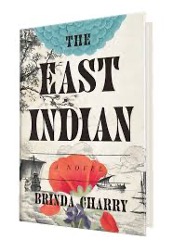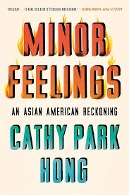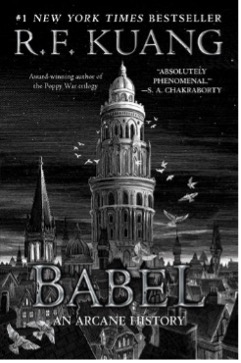May is Asian / Pacific Islander / South Asian American Heritage Month, making it a great time to feature materials created by, for, and about Asian Americans and Pacific Islanders. Join the Library in celebrating this heritage month and take a look at our librarians’ recommendations below!
“The East Indian” by Brinda Charry (Scribner 2023)
 A 1635 Virginia land record indicates the presence of “Tony East Indian.” No other details are known about this individual, but Brinda Charry seeks to recreate his life in this creative and historically faithful 2023 novel. She imagines Tony as a native of Madras, brought as an indentured servant first to London (where he is baptized and takes a Christian name), and then Virginia. Tony notes his outsider status in a society composed largely of Black and White (Native Americans remain a shadowy presence on the margins of the colony), but he skillfully navigates personal relationships and the nuances of race and class. An interesting perspective on Virginia at a time when racial categories were emerging but had not yet hardened into a system of perpetual lifetime bondage.
A 1635 Virginia land record indicates the presence of “Tony East Indian.” No other details are known about this individual, but Brinda Charry seeks to recreate his life in this creative and historically faithful 2023 novel. She imagines Tony as a native of Madras, brought as an indentured servant first to London (where he is baptized and takes a Christian name), and then Virginia. Tony notes his outsider status in a society composed largely of Black and White (Native Americans remain a shadowy presence on the margins of the colony), but he skillfully navigates personal relationships and the nuances of race and class. An interesting perspective on Virginia at a time when racial categories were emerging but had not yet hardened into a system of perpetual lifetime bondage.
– Keith Weimer
“Minor Feelings: An Asian American Reckoning” by Cathy Hong (One World, 2020)
 In a 2020 series of evocative intersectional essays, memoirist Cathy Park Hong contextualizes contemporary anti-Asian racism and racialized consciousness in America. From the origins of the 1917 Asian immigration ban and enforced racial segregation to the Korean War through to her own experiences as a child in California, a student in the Midwest and a published poet flown across America to read to white audiences, Hong acknowledges the complexities of experiences Asian Americans face. “Minor feelings are also the emotions we are accused of having,” Hong writes, “when we decide to be difficult — in other words, when we decide to be honest.” Hong uses her own stories to poetically explore the contradictory ways in which racial identity is trivialized, even by herself at times, as “minor and non-urgent,” displayed overtly and internalized, resisted and accepted.
In a 2020 series of evocative intersectional essays, memoirist Cathy Park Hong contextualizes contemporary anti-Asian racism and racialized consciousness in America. From the origins of the 1917 Asian immigration ban and enforced racial segregation to the Korean War through to her own experiences as a child in California, a student in the Midwest and a published poet flown across America to read to white audiences, Hong acknowledges the complexities of experiences Asian Americans face. “Minor feelings are also the emotions we are accused of having,” Hong writes, “when we decide to be difficult — in other words, when we decide to be honest.” Hong uses her own stories to poetically explore the contradictory ways in which racial identity is trivialized, even by herself at times, as “minor and non-urgent,” displayed overtly and internalized, resisted and accepted.
– Meg Kennedy
“Babel: Or the Necessity of Violence: An Arcane History of the Oxford Translators' Revolution” by R.F. Kuang (Harper Voyager, 2022)
 Words are magic, as we in libraries know, but they are especially so in Kuang’s 2022 novel. Eager student Robin Swift stumbles through truth and fiction at Oxford University (real, of course) and its Royal Institute of Translation (not real, of course) as he learns how to enchant translated language through a process called silver-working. His scholarship reveals identities, including his own, and leads him to discover the insidious nature of the Institute’s ensorcelled words. Babel is speculative historical fiction offering a somewhat grim but captivating commentary on the way academia has perpetuated colonialism. It’s also an analysis of friendship tested by both extraordinary events and the mundane stressors of being a student. Kuang, author of the fascinating, tenebrous “Poppy War” trilogy, again spellbinds the reader.
Words are magic, as we in libraries know, but they are especially so in Kuang’s 2022 novel. Eager student Robin Swift stumbles through truth and fiction at Oxford University (real, of course) and its Royal Institute of Translation (not real, of course) as he learns how to enchant translated language through a process called silver-working. His scholarship reveals identities, including his own, and leads him to discover the insidious nature of the Institute’s ensorcelled words. Babel is speculative historical fiction offering a somewhat grim but captivating commentary on the way academia has perpetuated colonialism. It’s also an analysis of friendship tested by both extraordinary events and the mundane stressors of being a student. Kuang, author of the fascinating, tenebrous “Poppy War” trilogy, again spellbinds the reader.
– Leigh Rockey
“Kitchen” by Banana Yoshimoto (Washington Square Press, 1993)
 Yoshimoto is a prolific Japanese author who rose to international fame with the 1993 translation of her award-winning 1988 novel. Similar in tone to Yoshimoto’s other novels, “Kitchen” is an engrossing, ethereal story exploring grief, routine, family, tradition, gender identity, food, and more seemingly divergent topics. In “Kitchen,” everyone is a philosopher, reflecting on their choices, surroundings, and inner dialogue. Yoshimoto’s presentation of trans characters reflects the prejudices of the protagonists, while the narration always uses correct pronouns. This tension reflects the relationship development through the novel; the close tracking and examination of interpersonal moments is characteristic of Yoshimoto’s work. While only thirteen of her novels have been translated into English, new translations are coming out regularly: we’ve been treated to a Yoshimoto translation in both 2022 and 2023.
Yoshimoto is a prolific Japanese author who rose to international fame with the 1993 translation of her award-winning 1988 novel. Similar in tone to Yoshimoto’s other novels, “Kitchen” is an engrossing, ethereal story exploring grief, routine, family, tradition, gender identity, food, and more seemingly divergent topics. In “Kitchen,” everyone is a philosopher, reflecting on their choices, surroundings, and inner dialogue. Yoshimoto’s presentation of trans characters reflects the prejudices of the protagonists, while the narration always uses correct pronouns. This tension reflects the relationship development through the novel; the close tracking and examination of interpersonal moments is characteristic of Yoshimoto’s work. While only thirteen of her novels have been translated into English, new translations are coming out regularly: we’ve been treated to a Yoshimoto translation in both 2022 and 2023.
– Mandy Rizki
